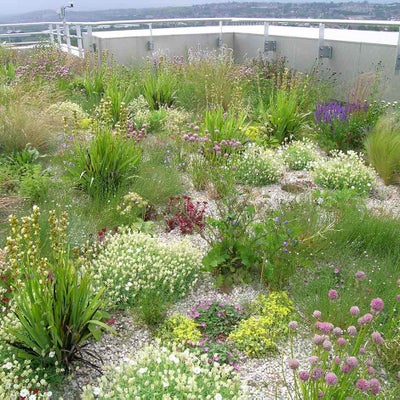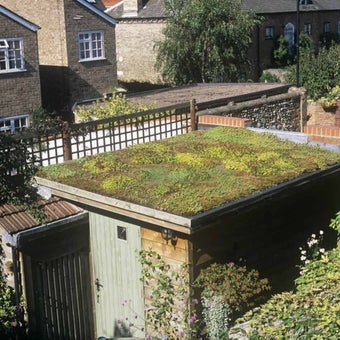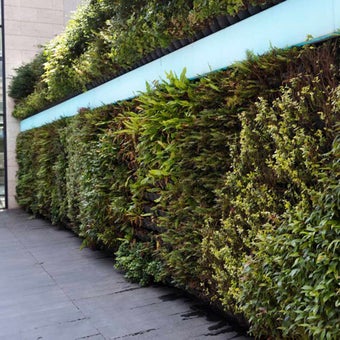
Quick facts
Suitable for - Many trees and shrubs, herbaceous perennials, alpines and spring-flowering bulbs
Timing - Spring or autumn
Difficulty - Moderate
Practical considerations
Before embarking on a project to make your roof garden into an oasis of greenery and flowers, the following important points should be considered:
Building restrictions
Before designing any addition to a property’s roof it is essential to check:
- Whether planning permission is required
- How much weight the roof can take – large containers full of compost and plants weigh a considerable amount, as do people using the garden. There will be strict weight restrictions on balconies suspended out from the building
- If the roof is waterproof. Use the services of a chartered structural engineer or a surveyor
Design and construction
- Use an architect specialising in roof garden design for complex projects
- Heavy containers should be placed near load-bearing walls or over a load-bearing beam or joist as these can take more weight than unsupported areas
- Modifications to roof supports can be made if the structural survey shows that support is insufficient
- Erecting a ‘false’ floor is a common method, where the roof surface is partly or completely suspended above the existing roof, directing weight onto surrounding walls
Local environmental conditions
- The main limitations of roof gardens and balconies are strong winds and sunshine. Take advantage of any existing protection, such as walls or fences that provide shelter and shade
- If erecting trellis or screens, ensure that any fixings are well-supported
- Solid walls can pose problems with turbulence on the leeward side so, if a choice is available, use slatted or mesh screens that simply filter the wind, creating a microclimate for the plants within
- Balconies also often have the additional problem of an overhang from the property above, which prevents rainfall from reaching the containerised plants
Compost and containers
- Containers will dry out rapidly in windy, hot weather so make sure they are a good width and depth. This will also accommodate plant roots and allow for further growth
- If using small containers, non-porous materials (plastic, metal and fibreglass) are better than terracotta as they reduce potential moisture-loss
- Ensure the container is lightweight and has ample drainage holes in the base
- Some companies, such as Green Tech Ltd, offer a range of light-weight soils and composts suitable for roof gardening
- Use a layer of lightweight drainage material at the base of the container
- A soil-based compost is better for its water-holding capacity than a peat-substitute mix, but will be heavier
- If weight is a consideration, and you use a peat-substitute mix, the container may need to be fixed so that it doesn’t blow over in strong winds
Irrigation and maintenance
- Containerised plants will need watering all year round, except in freezing conditions
- In summer, plants often need watering twice a day (if not more), and leaf scorching may occur even if plants are well-watered
- Containers should be raised off the ground so that their roots don’t get waterlogged
- Install an irrigation system where cost effective (in larger areas), ensuring excess runoff flows to a drainpipe outlet
- Hand-watering is more accurate, but time consuming
- Check containers periodically to ensure plant roots are not congested. Re-pot as necessary in spring
- Feed plants regularly. Controlled-release fertiliser used in the compost is the easiest solution
- Top-dress pots annually, replacing the top few centimetres with fresh compost
- Liquid feed any annual plants used in plantings from May to September to give the best flowering results
Plants for roof gardens and balconies
Depending on the level of exposure and altitude, a wide range of plants can be grown on a balcony or roof garden. The ideal method is to establish some shelter using screens or robust plants, which then creates a microclimate where other plants can survive.
- Plants that are tolerant of wind and sun tend to have leaf modifications that result in reduced surface evaporation. Examples are plants with needle-like leaves (pines, grasses or brooms) or very small leaves (cotoneaster or escallonia)
- Leaves can be covered in lots of hairs, giving the foliage a grey appearance. Lavenders and santolinas are examples
- Waxy cuticles protect plants like phormiums and cordylines from drying out
- Windbreak plants such as Pinus mugo tolerate sun and wind
- Dense, hardy evergreens such as Viburnum tinus and junipers can create shelter
- Low-growing, ground-cover plants can avoid the worst of the winds, or are sturdy enough to withstand them
- Alpines tolerate wind and sun, but will need protection from winter wet (usually by covering them with a sheet of perspex)
- Dwarf spring-flowering bulbs can also tolerate exposed sites
- Topiary specimens and window boxes can enhance the outlook from your property
Where to see roof gardens in the UK
- The Roof Gardens, Kensington High Street, London
- Jellicoe Roof Garden at House of Fraser, Guildford, Surrey
Other useful resources
When to plant roof gardens and balconies
Spring or autumn are ideal planting times, as the plants then have time to establish before the onset of harsher conditions.
Problems
With regular watering, feeding and maintenance (pruning, re-potting etc.), your balcony or roof garden should be relatively trouble-free. However, the following pest and weed problems are worth looking out for:
Algae, liverworts and moss on borders and containers
Aphids
Glasshouse red spider mite
Vine weevil











